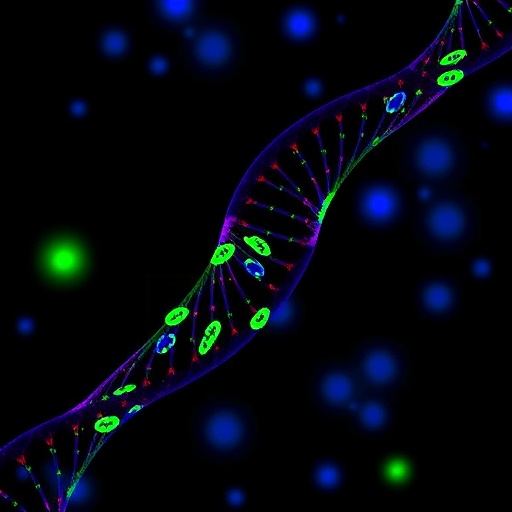In a groundbreaking study published in Nature Communications, a team of researchers, led by Varela-Vázquez and colleagues, has unveiled a critical molecular mechanism by which connexin 43 (Cx43) modulates the effectiveness of BRAF and MEK inhibitors in cancer therapy. This discovery could have profound implications for the treatment of malignancies harboring BRAF mutations, such as melanoma, by revealing a new layer of vulnerability in cancer cells linked to their DNA repair capabilities. The study’s findings potentially pave the way for improved therapeutic strategies that exploit the compromised DNA repair mechanisms induced by Cx43 activity.
Connexin 43, traditionally known as a gap junction protein facilitating intercellular communication, has recently come under the scientific spotlight for its multifunctional role in cancer biology. The current research identifies Cx43 as a crucial enhancer of cancer cell sensitivity to inhibitors targeting the BRAF/MEK signaling axis. These inhibitors have transformed the treatment landscape for patients with BRAF-mutant tumors; however, resistance invariably emerges. The novel insight that Cx43 reduces DNA repair capacity invites the intriguing hypothesis that modulating Cx43 levels or function might overcome or delay resistance development.
Mechanistically, this study shows that Cx43 expression correlates with impaired homologous recombination (HR) repair pathways, the very systems cancer cells rely on to mend double-strand breaks induced by genotoxic stress or therapeutic agents. By reducing the efficiency of HR, Cx43 effectively sabotages DNA repair machinery, rendering cancer cells more susceptible to DNA damage accumulation when exposed to BRAF and MEK inhibitors. This sensitization translates to increased apoptosis and tumor cell death, elevating the clinical utility of existing kinase inhibitors.
.adsslot_JXy5mOpcE8{ width:728px !important; height:90px !important; }
@media (max-width:1199px) { .adsslot_JXy5mOpcE8{ width:468px !important; height:60px !important; } }
@media (max-width:767px) { .adsslot_JXy5mOpcE8{ width:320px !important; height:50px !important; } }
ADVERTISEMENT
The investigators employed a comprehensive array of molecular and cellular techniques, including gene editing to manipulate Cx43 expression, high-resolution microscopy to observe gap junction dynamics, and sophisticated assays to quantify DNA repair proficiency. Their data revealed that Cx43 knockdown restored HR capacity and diminished drug sensitivity, whereas overexpression had the opposite effect. Such findings underscore the causative role of Cx43 levels in modulating DNA repair pathways and therapeutic outcomes.
This research also delves into the signaling cascades downstream of Cx43, implicating the disruption of key DNA repair proteins such as RAD51 and BRCA1. The reduction in protein levels and foci formation critical for homologous recombination suggests that Cx43 interferes at multiple points within the repair pathway. Notably, this interference does not arise from transcriptional changes but rather post-translational modulation, highlighting a complex regulatory mechanism that warrants further exploration.
From a clinical perspective, these insights raise the prospect of using Cx43 as a biomarker to predict patient responsiveness to BRAF/MEK inhibitors. High Cx43 expression in tumor biopsies could identify individuals likely to benefit from kinase inhibitor monotherapy or combination regimens that capitalize on impaired DNA repair. Conversely, tumors lacking adequate Cx43 might require additional therapeutic modalities to overcome intrinsic drug resistance.
Additionally, combining BRAF/MEK inhibitors with agents targeting DNA repair pathways, such as PARP inhibitors, might yield synergistic effects in Cx43-expressing tumors. This combinatorial approach could exploit synthetic lethality, where simultaneous compromise of DNA repair and oncogenic signaling overwhelms the tumor’s survival mechanisms, maximizing therapeutic efficacy while potentially reducing drug doses and side effects.
The study’s broader implications extend to understanding tumor heterogeneity and microenvironmental influences on drug response. Since Cx43 is central to cell-cell communication, its role in shaping the tumor niche and facilitating intercellular transfer of survival signals or DNA repair factors could influence how tumors adapt to targeted therapies. Dissecting these interactions might reveal novel vulnerabilities exploitable for intervention.
Moreover, the findings challenge the conventional perception of connexins solely as structural proteins by positioning Cx43 as a dynamic regulator of intracellular signaling networks linked to DNA damage response. This conceptual shift could inspire future research into other connexin family members and their potential roles in cancer progression and therapy resistance.
Importantly, the research team highlights the temporal aspect of Cx43’s effect, noting that Cx43-mediated DNA repair disruption appears most critical during early drug exposure phases. This timing could inform treatment scheduling and the design of sequential or adaptive therapeutic regimens aimed at sustaining maximal tumor cell kill while minimizing resistance.
The neurobiological functions of Cx43 and its implication in various cancers necessitate a careful assessment of potential off-target effects or toxicity associated with manipulating this protein therapeutically. The study suggests that targeted delivery systems or context-specific modulation might mitigate such concerns, enabling the safe translation of these findings into clinical applications.
These results also raise intriguing questions regarding the evolutionary significance of Cx43’s dual roles in maintaining tissue homeostasis and modulating DNA repair in pathological conditions. Understanding how cancer cells exploit such native cellular mechanisms could unlock new avenues for intervention beyond genetic mutations to encompass broader systems biology strategies.
The meticulous experimental design and robust validation performed by Varela-Vázquez et al. provide a compelling rationale for initiating clinical trials that integrate Cx43 status into patient stratification. Such trials could evaluate whether Cx43-centric approaches enhance long-term survival and delay resistance onset in patients receiving BRAF or MEK inhibitor therapy.
In conclusion, this landmark study uncovers a previously unappreciated function of connexin 43 in sensitizing BRAF-mutant tumors to kinase inhibitors through the attenuation of DNA repair pathways. By bridging molecular biology, oncology, and therapeutic innovation, these findings could revolutionize personalized cancer treatment paradigms and open fresh horizons for combating drug-resistant malignancies.
Subject of Research: The role of connexin 43 (Cx43) in modulating DNA repair capacity and enhancing the efficacy of BRAF/MEK inhibitors in cancer therapy.
Article Title: Cx43 enhances response to BRAF/MEK inhibitors by reducing DNA repair capacity.
Article References:
Varela-Vázquez, A., Guitián-Caamaño, A., Carpintero-Fernández, P. et al. Cx43 enhances response to BRAF/MEK inhibitors by reducing DNA repair capacity. Nat Commun 16, 6168 (2025). https://doi.org/10.1038/s41467-025-60971-3
Image Credits: AI Generated
Tags: BRAF MEK inhibitor effectivenessconnexin 43 role in malignanciesCx43 and cancer therapyDNA repair mechanisms in cancerenhancing cancer cell sensitivityhomologous recombination pathwaysintercellular communication in cancermelanoma treatment advancementsmolecular mechanisms in oncologyovercoming resistance in cancer therapyresistance to cancer treatmenttherapeutic strategies for BRAF mutations





